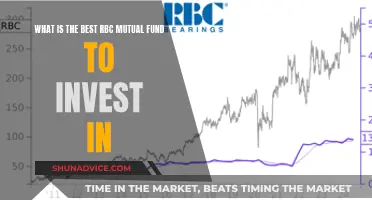
Investing in mutual funds can be a great way to diversify your portfolio and access the expertise of professional money managers. Franklin Templeton is one of the most well-known and respected mutual fund companies in the world, offering a wide range of investment options to suit different needs and goals. When investing in Franklin Templeton mutual funds, there are a few key steps to follow. First, you'll need to open an account with the company and decide how much you want to invest. You can then choose from a variety of funds, each with its own investment strategy and focus. It's important to research the different funds and understand the risks and potential rewards before investing. Once you've made your decision, you can purchase shares in the fund and start growing your investment.
What You'll Learn

Choosing the Right Scheme
When it comes to investing in mutual funds, one of the most important steps is choosing the right scheme to align with your financial goals. Franklin Templeton offers a wide range of mutual fund schemes, and here's a guide to help you make an informed decision on how to choose the right one for your investment journey:
Understanding Your Financial Goals
Before investing in any mutual fund scheme, it's crucial to define your financial goals. Are you saving for retirement, planning for a child's education, or looking to purchase a home? Each goal will have its own timeline and risk tolerance, which will help guide your investment strategy. For example, if you're saving for a short-term goal like a down payment on a car, you may opt for more conservative investments to protect your capital. On the other hand, if you're investing for retirement, which is typically a long-term goal, you may be more aggressive in your investment choices to maximize potential returns.
Evaluating Risk and Return
Every mutual fund scheme has a different risk-return profile. Franklin Templeton provides detailed fact sheets and offer documents for each scheme, outlining the investment objectives, strategies, and associated risks. It's important to review these documents to understand how the fund invests your money and the potential risks involved. Consider your risk tolerance and ensure that the scheme aligns with your comfort level. Generally, equity funds carry higher risks but offer potential for higher returns, while debt funds are considered less risky but may provide more modest returns. Balanced funds, as the name suggests, offer a mix of equity and debt investments to balance risk and return.
Analyzing Past Performance
While past performance doesn't guarantee future results, reviewing how a mutual fund scheme has performed historically can provide insights into its potential. Look at the scheme's performance over different time periods, especially during market highs and lows, to gauge its consistency. Compare the scheme's returns with relevant benchmarks and similar funds in the same category to identify top-performing funds. However, remember that higher past returns don't always indicate higher future returns, as market conditions vary over time.
Understanding Costs Involved
Mutual fund investments come with certain costs, such as fund management fees, distribution fees, and other expenses. These fees can vary across different schemes and impact your overall returns. Be sure to review the scheme's offer document to understand all associated costs. While a higher expense ratio doesn't necessarily indicate poor returns, it's important to ensure that the fund's performance justifies its fees. Some funds may offer lower costs but still provide competitive returns, so it's worth comparing these factors across different schemes.
Assessing Investment Horizon
Different mutual fund schemes cater to different investment horizons. Some funds are designed for short-term goals, offering liquidity and stability, while others are meant for long-term wealth creation. Depending on your financial goals, choose schemes that align with your time horizon. For instance, equity funds are typically suited for long-term goals, as they can provide higher returns over time but may be more volatile in the short term. On the other hand, liquid funds or ultra-short-duration funds are suitable for short-term goals, as they offer relatively stable returns and easy redemption options.
By following these guidelines and conducting thorough research, you can make an informed decision when choosing a Franklin Templeton mutual fund scheme that aligns with your financial goals, risk tolerance, and investment horizon. Remember to review your portfolio periodically and consult a financial advisor if needed to ensure your investments remain on track.
Mutual Funds: Bulk Investment Strategies for Maximum Returns
You may want to see also

Understanding Risk Factors
When investing in Franklin Templeton mutual funds, there are several risk factors that investors should be aware of. Understanding these risks is crucial for making informed investment decisions and ensuring that your investments align with your financial goals and risk tolerance. Here are some key risk factors to consider:
Market Risk:
Market risk is inherent in any investment, including mutual funds. The value of Franklin Templeton mutual funds can fluctuate due to changes in the overall market conditions. Unfavourable market movements can lead to losses in your investment. It's important to remember that different types of mutual funds have varying levels of market risk. For example, equity funds are generally considered riskier than fixed-income funds.
Management Risk:
While Franklin Templeton offers the benefit of professional management by experienced fund managers, this aspect also carries a certain level of risk. The performance of your investment is dependent on the decisions made by these fund managers. Poor investment strategies or changes in fund management can result in underperformance or loss of investment value.
Fees and Expenses:
Mutual funds come with various fees, such as management fees, distribution fees, and other expenses. Franklin Templeton mutual funds are no exception. Over time, these fees can accumulate and eat into your investment returns. Before investing, carefully review the fee structure of the specific fund you are considering. Make sure you understand all the associated costs, as they can impact your overall profitability.
Investment Objective and Risk Profile:
Each mutual fund offered by Franklin Templeton has its own investment objective and risk profile. It is essential to understand that not all funds are suitable for every investor. Some funds may have investment strategies that align with your financial goals, while others may not. Consider your own risk tolerance and investment horizon when evaluating different funds.
Liquidity Risk:
Although Franklin Templeton mutual funds offer the ability to redeem your investment at any time, there may be certain restrictions or fees involved. Redemption fees are typically charged if you redeem your investment shortly after purchasing it. Additionally, in certain market conditions, it may be challenging to find a buyer for your mutual fund shares, potentially impacting your ability to liquidate your investment quickly.
It is important to remember that investing in mutual funds, including Franklin Templeton mutual funds, involves a combination of these and other risks. Before making any investment decisions, carefully consider your own financial situation, investment goals, and risk tolerance. Regularly reviewing and adjusting your investment portfolio can help ensure that it remains aligned with your long-term financial objectives.
College Fund: When to Shift to Safer Investments?
You may want to see also

Investing via SIP or Lumpsum
There are two ways to invest in a mutual fund: a Systematic Investment Plan (SIP) or a one-time lump-sum investment. The best method for you will depend on your financial situation and goals.
Systematic Investment Plan (SIP)
SIPs allow you to invest a small amount of money at regular intervals, such as daily, monthly, quarterly or semi-annually. This is a good option if you don't have a large amount of money to invest in one go. You can start investing with a small amount, such as Rs 500 per instalment, and increase the amount over time. SIPs are flexible, and you can pause or stop them at any time without penalty.
SIPs are a good way to reduce the risk of losing money if the market crashes, as your money is spread over time, and only a small part of your investment will be affected by market volatility. This also means that you can benefit from market highs without putting a large amount of money at risk.
SIPs also offer the benefit of rupee-cost averaging, where you buy more units when the market is down and fewer when the market is up, reducing the per-unit cost of purchasing the units. SIPs also allow you to benefit from the power of compounding, as you earn returns on the returns generated by your investment.
Lump Sum
If you have a large amount of disposable money and a higher risk tolerance, a lump-sum investment may be suitable. This is a good option if you are investing during an upward market trend, as it can provide higher returns than SIPs in these conditions. However, if the market is volatile or falling, you could lose a large portion of your investment.
The answer to this depends on your financial situation and goals, as well as market conditions. If you are just starting your professional career, a SIP is a good way to gain exposure to equities with a low level of risk. If you have a large amount of money to invest and are comfortable with the risks, a lump-sum investment could provide higher returns during an upward market trend.
Target Date Funds: A Guide to Investing for Retirement
You may want to see also

Tracking Performance
Tracking the performance of your mutual fund investments is crucial to ensure your financial goals are being met. While financial experts are invaluable partners in your investment journey, it is beneficial to understand your investments to a certain degree. Here are some ways to track the performance of your mutual funds:
Fund Fact Sheet
A fund fact sheet is a basic document that provides an overview of a mutual fund scheme's performance and portfolio. Published monthly by each mutual fund, it includes details such as the fund's annualised return and important ratios like standard deviation, Beta, and Sharpe Ratio. The fact sheet allows you to compare the fund's performance against its benchmark and similar funds in the same category.
Online Platforms and Mobile Apps
Several websites and mobile applications are specifically designed to track mutual fund performance. These platforms provide valuable insights into scheme performance and can often be customised to monitor a particular portfolio. Additionally, popular business publications and newspapers regularly feature reviews and commentaries on mutual funds, offering another perspective on their performance.
Historical Performance Data
While past performance does not guarantee future results, analysing historical data can provide context on how a fund has navigated different market cycles. This data can also help evaluate the fund manager's skill and the consistency of the fund's returns relative to the risks undertaken.
Financial Ratios
Financial ratios, such as the fund's Alpha, Beta, and Sharpe Ratio, offer a more detailed analysis of a fund's performance. The Alpha indicates the fund manager's skills and strategies, while the Beta provides insight into the fund's volatility compared to the benchmark. The Sharpe Ratio informs you of the additional return you receive for taking on extra risk.
Peer Comparison
It is challenging to assess a mutual fund in isolation. Therefore, creating a shortlist of comparable funds and regularly comparing their performance is essential. FinTech firms and third-party websites often provide free tools to screen and compare mutual funds, making it easier to evaluate their performance relative to one another.
Performance Against Index
Indexes like the Nifty, BSE Sensex, and BSE 200 serve as benchmarks for evaluating fund performance. Comparing a fund's performance against these indexes and its peers can provide valuable insights. A well-managed fund should not experience significant declines during market downturns.
Remember, monitoring the performance of your mutual fund investments is an ongoing process. While you don't need to check daily, evaluating your fund every six months to a year is generally recommended, depending on your investment's tenure. This allows you to make informed decisions, adjust your portfolio if needed, and work towards achieving your financial objectives.
Vanguard Mutual Funds: Best Retirement Investment Options
You may want to see also

Redemption Process
Redeeming your mutual fund investment from Franklin Templeton is a straightforward process that can be initiated through their website or mobile app. Here is a detailed guide on how to go about the redemption process:
Step 1: Log In to Your Account
Visit the Franklin Templeton Investor Services website or open their mobile app. Log in to your account using your credentials. If you haven't registered for an online account access yet, you can do so by providing your basic information and the details of your mutual fund investment.
Step 2: Navigate to the Redemption Section
Once you are logged in, look for the "Redeem" or "Sell" option. This is usually found under the "Account Transactions" or a similarly named menu. Click on this option to initiate the redemption process.
Step 3: Select the Mutual Fund and Amount
You will be presented with a list of your mutual fund holdings. Select the particular Franklin Templeton mutual fund that you wish to redeem. Then, specify the number of units or the amount in dollars that you want to redeem. You can choose a full or partial redemption, depending on your needs.
Step 4: Review and Confirm
Carefully review the details of your redemption request, including the fund name, amount, and any applicable fees or charges. You may also need to select your preferred mode of payment for the redemption amount. Confirm the transaction if all the details are correct.
Step 5: Processing and Payment
After you have confirmed the redemption request, Franklin Templeton will process it based on their cut-off times. Typically, redemption proceeds are sent via check or electronic transfer to the bank account registered with your mutual fund account. The time taken for the proceeds to reach you may vary, depending on the type of fund and the processing time specified by Franklin Templeton.
Additional Information:
- Redemption fees: Some Franklin Templeton funds may charge a redemption fee to cover administrative costs associated with redeeming your investment. This fee is typically waived for certain types of distributions, such as systematic withdrawal plans.
- Cut-off times: Redemption requests received before the cut-off time (usually specified by Franklin Templeton) will be processed on the same business day. Requests received after the cut-off time will be processed on the next business day.
- Distributions: You can choose to receive your redemption proceeds as a lump sum or set up regular distributions. The latter option is useful if you want to receive a steady income from your mutual fund investment.
- Tax implications: Remember to consider the tax implications of redeeming your mutual fund investment. Depending on your holding period and the type of account, you may be subject to capital gains taxes. Consult a tax advisor to understand the specific tax consequences of your redemption.
By following these steps, you can conveniently redeem your Franklin Templeton mutual fund investment and access your funds as per your requirements. Remember to carefully review the fund's prospectus and disclosure documents for any specific guidelines or restrictions related to redemptions.
Equity Funds in the Philippines: A Beginner's Guide to Investing
You may want to see also
Frequently asked questions
To invest in a Franklin Templeton mutual fund, you first need to determine your financial goals and risk tolerance. Then, you can browse the range of funds offered by Franklin Templeton and choose the fund or funds that align with your goals and risk profile. You can invest directly through the Franklin Templeton website or mobile app, or you can consult a financial advisor to guide you through the process.
Franklin Templeton offers a wide range of mutual funds, including equity funds, debt funds, hybrid funds, and tax-saving funds. Equity funds primarily invest in stocks, offering potential for higher returns over the long term but with higher risk. Debt funds invest in fixed-income securities and are generally considered lower risk but with relatively lower returns. Hybrid funds invest in a combination of stocks, bonds, and other securities, offering a balanced approach. Tax-saving funds offer tax benefits under specific sections of the Income Tax Act.
Selecting the right mutual fund depends on your financial objectives, risk appetite, and investment horizon. Consider your short-term and long-term goals, and choose funds that align with these goals. Assess your comfort with risk and understand the risk profile of the fund. Look at the fund's historical performance, but remember that past performance does not guarantee future results. It's also important to review the fund's portfolio and understand the sectors and industries it focuses on. Consulting a financial advisor can help you make an informed decision based on your specific circumstances.







